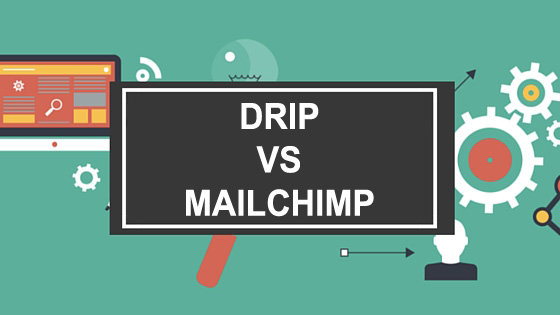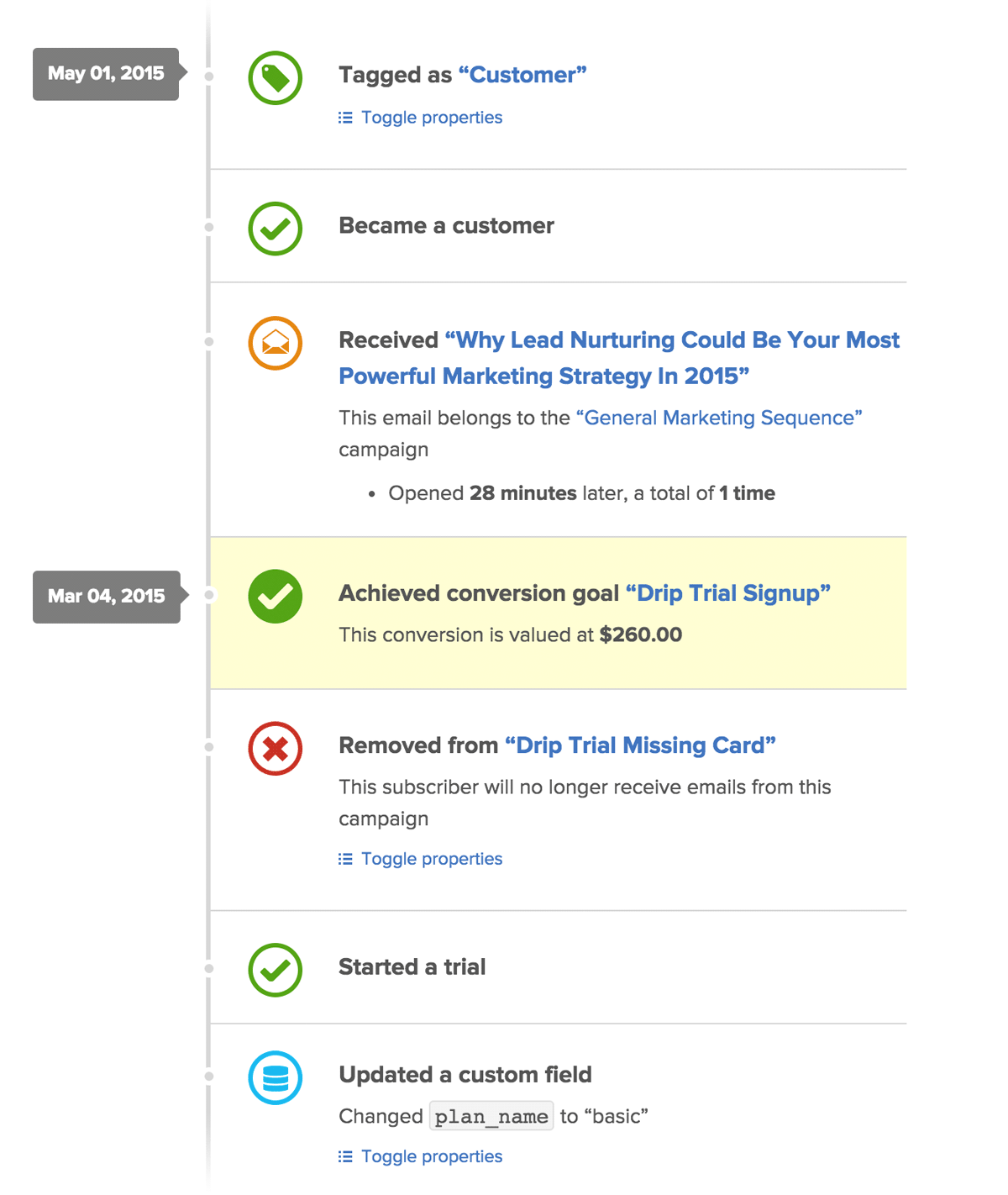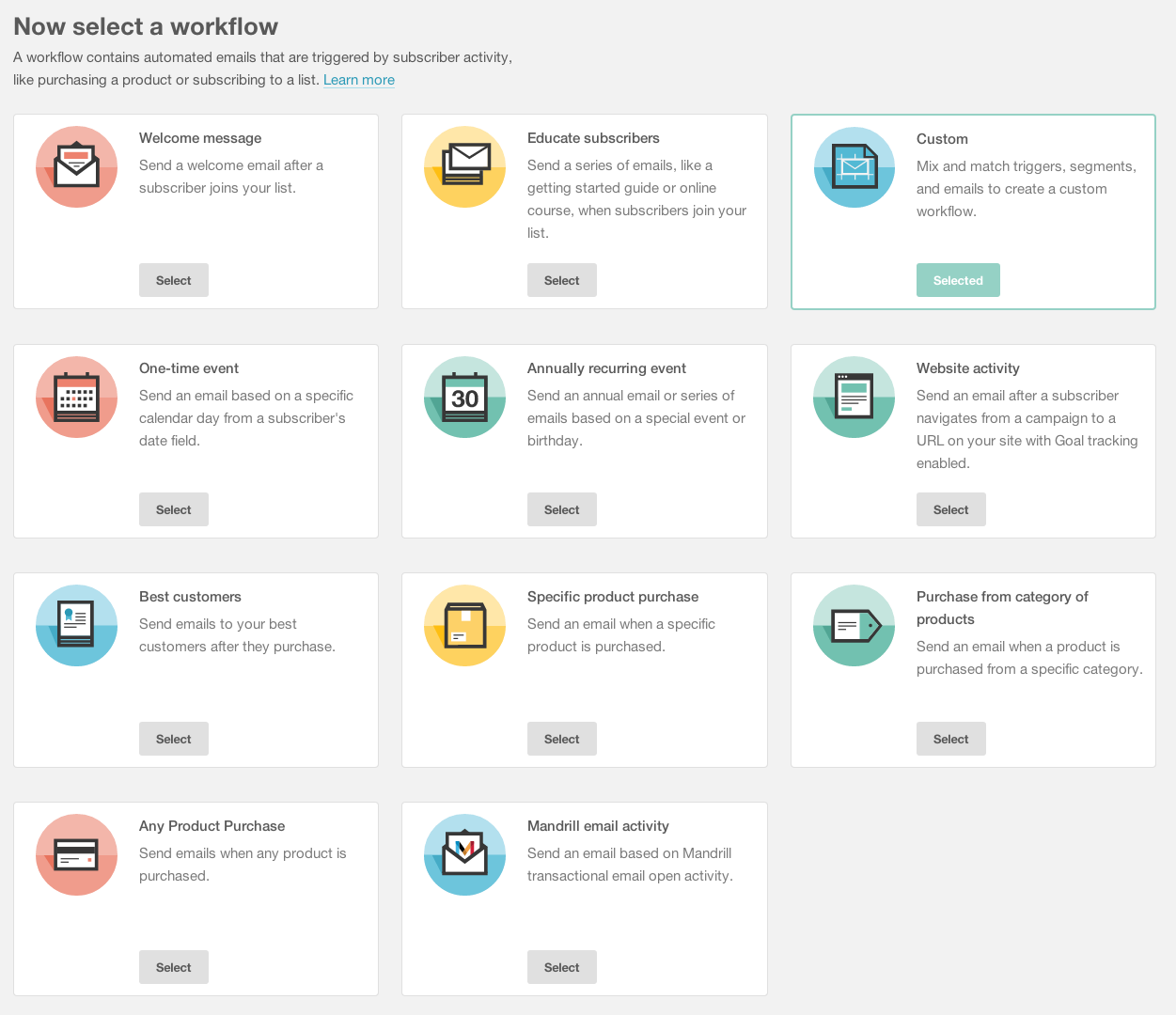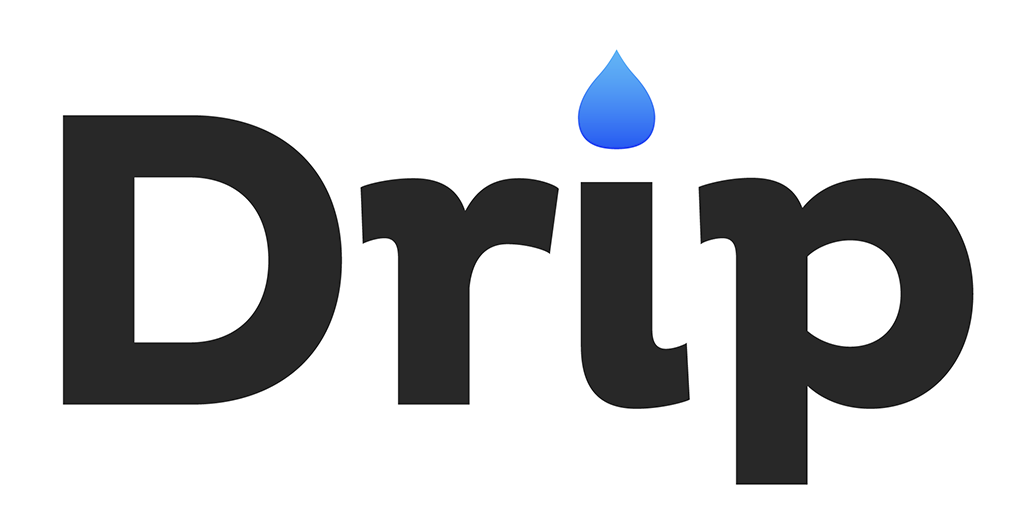Confused between the two? Here's our quick summary:
Drip is designed specifically with marketing automation in mind. It’s ideal for small businesses that want to send event-based emails to their customers. It’s also designed to only handle one mailing list per account, making it ideal for small businesses but pretty bad for agencies.
MailChimp, on the other hand, has more of an “old school” feel to it. It allows for multiple lists and campaigns, and includes a huge variety of email templates to help you quickly and easily send out professional looking catalogs, vouchers and other promotional content.
At first glance, both tools look fairly similar, with a good selection of email marketing and marketing automation features. Dig deeper, however, and there are some clear differences between Drip and MailChimp that are worth considering.
For the most part, bloggers and digital product sellers (people that sell eBooks, software and other intangible products) will prefer Drip, while you’ll probably prefer MailChimp if you want your emails to have a more polished, “corporate” feel.

Below, I’ve compared Drip (Visit Website) and MailChimp (Visit Website) by looking at their features, design and overall versatility as email marketing tools. I’ve also shared my specific recommendations about which types of businesses will like Drip, versus the businesses that will like MailChimp.
Don’t have time to read this entire guide? Here’s a quick and simple recommendation that will save you some time:
- 95% of people will prefer Drip to MailChimp, especially if you want a tool that’s designed specifically for marketing automation. Drip feels like a dedicated marketing automation tool, whereas MailChimp’s automation features feel like an afterthought.
- The only time you’ll want to use MailChimp over Drip is if you need to give your emails a more conventional, HTML-like feel. Drip doesn’t include email templates, which means it can only do plain text. If you want your emails to “pop” and look polished, get MailChimp.
Can’t decide which tool is the best option for you? Keep reading for my full feature comparison and review.
| Specs | Drip | MailChimp |
|---|---|---|
| Designed For | Bloggers and SaaS/product owners seeking a user-friendly, lightweight marketing automation system. | Bloggers and small business owners in need of a simple, user friendly email marketing platform. Marketers seeking a free email marketing platform. |
| Email Marketing Automation | View Product | View Product |
| Contacts | Plans starting from 100 contacts. | Up to 2,000 subscribers on free plan. Custom plans available for up to millions of subscribers. |
| Email Volume | Unlimited emails on all plans. | Up to 12,000 emails per month on free plan. Paid plans offer unlimited emails. |
| Users | Not provided on Drip website | Additional users with custom permissions can be added to all MailChimp accounts. |
| Email Courses | Unlimited autoresponders on all plans. | Unlimited autoresponder series on all plans except free plan. |
| Automation Rules | Unlimited automation rules on all plans. | Unlimited autoresponder series on all plans. |
| Responsive Email Templates | Liquid templating system with custom email templates. | Pre-build responsive email templates are included, as well as an email designer tool. |
| Email Split Testing | A/B split testing for subject lines, send times and sender names. | A/B email split testing is available, with up to three variables per test. |
| Lead Scoring | Lead scoring based on website/email engagement. | Lead scoring and segmentation using "Goal" -- MailChimp's behavioral tracking script. |
| SMS Marketing Automation | Drip does not support SMS marketing automation. However, subscription via SMS is available using the Textiful integration. | MailChimp supports SMS marketing automation via the Text Marketer integration. |
| Direct Mail Automation | Drip does not support direct mail automation. | MailChimp does not natively support direct mail automation. However, a MailChimp & Direct Mail Zapier integration is available. |
| UI and Usability | Designed for bloggers and SaaS/product owners, with an extremely lightweight and user-friendly interface. | Clean, user-friendly interface designed for people without coding or technical knowledge. |
| Automation Workflow Builder | User-friendly visual workflow builder with easily understandable yes/no logic and six different automation flow steps. | Easy-to-use automation workflow builder with pre-built automations and a variety of preset automation workflows. |
| Email Course Builder | Three ways to send targeted emails: in a drip campaign, as a broadcast, or as a one-off event-based email. | Email autoresponder courses are easy to create, schedule and configure. |
| Forms & Landing Pages | View Product | View Product |
| Form Builder | Built-in form editor with four different opt-in form styles: widget, embedded, exit triggered and hosted. | Form builder with custom buttons, images, drop-down boxes, and more. Embedded and pop-up forms can be created. |
| Landing Page Builder | No landing page builder, although integrations are available for LeadPages and Instapage. | MailChimp does not have a landing page builder. However, it integrates with Instapage, Leadpages and other landing page tools. |
| Landing Page Templates | No landing page templates included. | No landing pages included with MailChimp. |
| WordPress Plugin | Email Marketing by Drip WordPress plugin makes adding opt-in forms to your WordPress website a one-click process. | MailChimp for WordPress lets you add great looking opt-in forms to your WordPress website in just a few clicks. |
| Integrations | Dozens of integrations for software such as Instapage, LeadPages, Stripe, Zapier, PayPal, Shopify, Wistia and more. | More than 700 integrations with landing page, analytics, CRM and payment processing software. |
| Zapier Integration | Supported. | Supported. |
| Pricing | Monthly fee, starting from $1 per month for up to 100 subscribers. Three week free trial available. | Free for under 2,000 subscribers. Paid plans start from $10 per month. |
| Minimum Contract Term | No minimum contract. Plans start from one month. | No minimum contract. Plans start from one month. Pay-as-you-go email credits are also available. |
| Joining/Training Fee | No joining fee. | No joining fee. |
| Refund/Guarantee | Drip guarantees that its software will help you grow your list and improve conversions. If not, you can request a refund for your most recent payment. | MailChimp will refund a prorated portion of your monthly prepayment or reimburse you for unused Email Credits if your account is closed without cause. |
| Support | Personalized support via email. | Personalized support via email, as well as online support resources. |
| Wesbite | View Product | View Product |
How do Drip and MailChimp compare in terms of features?
Drip and MailChimp have a lot of common features. They also have some key differences, such as the way they handle lists and the way their emails look (Drip’s are simple, while MailChimp is packed with eye-catching email templates).
Opt-in Forms & Landing Pages: Drip Wins on Opt-Ins
Winner: Drip, which has better looking opt-in forms. Neither tool has a landing page builder, so there’s no winner in that category.
Drip and MailChimp both include opt-in form builders that are easy to use, even for people with no web design experience. Neither software comes with a landing page builder, meaning you’ll need to use a third party tool like Instapage or Leadpages to create your landing pages.
Drip: Better Looking, More Modern Opt-In Forms, But No Landing Pages
Drip has an easy-to-use opt-in form builder that lets you create and customize opt-in forms for your website in just a few clicks.
Even if you’re totally new to web design and have no HTML or CSS knowledge, you can easily adjust things like your form’s color scheme and style using Drip’s form builder.
The form builder in Drip is designed with simplicity in mind, which means you don’t have quite as much flexibility over the look and feel of your opt-in forms as you would get from some other email marketing platforms. The upside of this is that it’s extremely easy to use.
Opt-in forms in Drip take several forms. You can choose from a widget that looks like a live chat window, an embedded HTML form that’s perfect for sidebars, an exit-triggered popup to capture emails from visitors as they leave your website, and a simple hosted HTML form.
Most bloggers and content marketers will want to use the widget, embedded and exit-triggered form options. Drip provides a convenient WordPress plugin that makes adding opt-in forms to your WordPress site a simple process.
If you don’t use WordPress, adding a Drip opt-in form to your website is as simple as copying and pasting the HTML embed code.
Drip does not come with a landing page builder, which is a minor annoyance. However, it does come with integrations for Leadpages, Instapage and other landing page tools, allowing you to quickly and easily add Drip forms to your existing landing pages and start building your list.
All in all, Drip’s opt-in forms are designed with simplicity in mind, making them a good option for bloggers and content marketers that want to focus on marketing instead of learning HTML and CSS.
MailChimp: Simpler, “Old School” Forms That Look a Little Clumsy
MailChimp’s opt-in form builder lets you create a huge variety of custom opt-in forms. Using the form builder, you can customize your form’s fields to capture data like names, phone numbers, website URLs, addresses, zip codes, birthdays and more — data that other tools won’t capture.
You also get a huge level of control over how your forms look. MailChimp lets you customize things like your form’s background color, text color, line height, fonts, buttons and more. If you want to, you can even customize the type of MailChimp badge you show to your visitors.
MailChimp also has a translation feature that lets you display your form’s content in languages other than English. It can even auto-translate your form based on the viewer’s location to help increase conversions in non-English speaking countries.
Adding opt-in forms created in MailChimp to your website is fairly easy. MailChimp provides a list of WordPress plugins on their website, most of which let you add your MailChimp forms to WordPress as a widget or using a shortcode.
You can also embed your form using the code snippet MailChimp provides — a better option for static HTML sites.
Like Drip, MailChimp doesn’t include landing pages and has no landing page builder. However, it does integrate with tools like Unbounce, Instapage, and Leadpages, letting you add MailChimp forms to your existing landing pages.
Email Marketing Automation: Drip Wins By a Mile
Winner: Drip, which has a more intuitive email marketing automation module that feels much less “bolted on” than MailChimp’s.
Drip and MailChimp both include a great range of email marketing and marketing automation features. However, they both have different focuses. If you want a marketing automation tool, you’ll probably like Drip. If you want a traditional email marketing tool, you’ll like MailChimp.
Drip: Designed Purely for Email Marketing Automation

Drip feels like a marketing automation tool first and foremost, meaning it’s the best option if you want to send event-based emails and don’t need a lot of traditional email marketing features like email templates or a custom email builder.
Drip includes email sequences (called “drip campaigns”) and broadcasts, meaning you can use it as a traditional email marketing platform. However, the focus is on automation, and Drip has a great range of features to help you automate almost every aspect of your email marketing.
Automation in Drip is handled using the workflow builder — a simple visual tool that lets you set up automated actions for everything from sending specific emails to tagging subscribers based on their actions.
There are 18 automation triggers and 16 different actions in Drip, letting you program specific actions when customers click a certain link, visit a specific URL, make a purchase or join your free trial.
Drip also comes with lead scoring, letting you see which of your subscribers are the most active based on the number of events they’ve completed. There’s also a segment builder, letting you segment your audience and focus on marketing to your most engaged, valuable customers.
Using Drip’s analytics tools, you can keep track of everything from subscriber activity to your email campaign’s key performance metrics. Drip even gives you the option to automatically remove inactive subscribers from your list to lower costs and keep performance up.
All in all, Drip feels like it’s designed for marketing automation first and foremost and traditional email marketing second. There are no email templates — instead, there are simple HTML and plain text emails — but the automation features are easy to use and quite powerful.
MailChimp: Conventional Email First, Marketing Automation Second

While Drip is a marketing automation tool that includes traditional email marketing tools as an afterthought, MailChimp is the opposite — a traditional email marketing platform that’s also got an automation module.
If you’re part of an e-commerce business or digital marketing agency, you’ll probably appreciate MailChimp’s focus on regular email marketing.
MailChimp comes with a huge variety of email templates, letting you quickly and easily design emails for your latest sale, discount offer or giveaway. There’s also a powerful email template builder that lets you create your own custom emails with ease.
Unlike Drip, which only allows one list per account, MailChimp allows you to create as many different lists and campaigns as you want, making it ideal for agencies and larger businesses that prefer to split their customer audiences using lists instead of segments.
You’ll find all of the usual email marketing features in MailChimp, ranging from broadcasts to autoresponders. Using MailChimp, you can configure your emails to be send at a certain time, or even use the Timewarp feature to sync your emails with each customer’s time zone.
MailChimp also includes some powerful email marketing automation features. You can create rules based on customer behavior and send emails for things like abandoned cart recovery or post-sale follow-ups.
However, MailChimp is a traditional email marketing tool first and foremost, and the automation features feel a little tacked on compared to Drip, which is built around automation.
Of the Two Platforms, Which Has The Best Features?
Drip and MailChimp both have impressive ranges of features, but they’re different tools built to focus on different things.
Drip is designed from the ground up for people that need a marketing automation platform. It’s very lacking when it comes to traditional email marketing, making it a good option for software startups and a less useful option for e-commerce retailers and digital marketing agencies.
MailChimp is designed with traditional email marketing in mind, and only recently added email marketing automation features. If you want lots of HTML email templates and the ability to add multiple lists to your account, you’ll like MailChimp much more than Drip.
Pros & Cons of Drip
The biggest advantages of Drip are its simplicity and great range of email marketing automation features. Its biggest downside is its lack of email templates, making it less than ideal if you run a digital agency or e-commerce business.
Pros
- Although Drip isn’t the simplest email marketing automation tool on the market, it’s quite easy to use. Even if you have no programming experience, you’ll be able to make your own workflows with confidence after a few hours of practice.
- Drip’s opt-in forms are simple and load quickly, making them a good addition to blogs and lead generation websites.
- Drip’s traditional email marketing features aren’t particularly powerful, but they’re very easy to use and perfect for bloggers, content marketers and digital product developers.
- Emails sent by Drip are plain text or simple HTML, making them easy for recipients to read and helping to avoid the “corporate” look that some email templates can have.
- Drip includes great analytics features that let you monitor every aspect of your email campaigns, from subscriber engagement to conversions and revenue.
- Drip is available for free with a list size restriction of 100 subscribers, letting you test it out on a small audience before committing.
Cons
- Drip is a marketing automation tool first and foremost, and it lacks some basic features like landing pages and email templates.
- There are no landing pages included with Drip, meaning you’ll need to use a third party tool like Instapage or Leadpages if you plan on running a PPC campaign.
Overall
If you’re looking for a powerful but relatively easy to use email marketing automation platform that’s built with SaaS businesses in mind, Drip is a great choice. Just keep in mind that it isn’t really designed for conventional broadcast and autoresponder email marketing.
Pros & Cons of MailChimp
MailChimp is much more of a conventional email marketing tool than Drip, with a great range of email templates and features that will appeal to e-commerce businesses, agencies and brands that prefer the “old fashioned” approach to email.
Pros
- MailChimp comes with a huge selection of email templates for everything from promos to sales, new subscriber welcomes and more.
- Using MailChimp’s powerful email editor, you can customize your emails to look exactly the way you want them to look.
- MailChimp’s free trial allows you to build a list of up to 2,000 subscribers, making it better as a free tool than Drip, which limits your list size to just 100 subscribers.
- Since MailChimp integrates with a massive range of other products, it’s easy to integrate it into your marketing software toolkit.
- While MailChimp’s automation features aren’t the best in the industry, they’re easy to use and offer more than enough power for most small businesses and agencies.
- MailChimp integrates with most e-commerce platforms, making it a good choice if you use Shopify, Magento, WooCommerce or another e-commerce platform to power your business.
Cons
- There are no landing pages included with MailChimp, so you’ll need to use Leadpages, Instapage, Unbounce or another landing page platform if you plan on driving traffic to a landing page.
- Since MailChimp is designed for traditional email marketing first and foremost, it feels a little bit “lightweight” as a marketing automation platform compared to Drip.
Overall
MailChimp is one of the best platforms out there for conventional email marketing thanks to its powerful email builder and large selection of templates. If you need professional looking emails and don’t care as much about marketing automation, you’ll definitely like MailChimp.
Pricing
Drip is available free, although you’ll be capped at 100 subscribers unless you become a paying customer. Paid plans start from $41 per month when paid annually and give you a maximum list size of 2,500 subscribers and full access to Drip’s features.
If you have more than 5,000 subscribers, you’ll need to contact Drip for pricing information. On the whole, Drip is a little expensive compared to other email marketing tools, especially for users with large audiences.
MailChimp has a free plan that lets you add up to 2,000 subscribers and caps your monthly email volume as 12,000. The free plan also limits your access to some MailChimp features, although it includes all of the email marketing and marketing automation features you’ll want to use.
Paid MailChimp plans start from $10 per month, although you’ll need to pay more than this for a plan with unlimited emails. The Pro Marketer plan, which includes some special features aimed at enterprise users, costs $199 a month on top of the regular subscription fee.
Overall, MailChimp is quite a lot cheaper than Drip. For a list size of 2,500 with unlimited emails, MailChimp costs $30, making it almost 30% less expensive than the $41 you’d pay for the same list size with Drip.
Support
Drip and MailChimp both offer good support, although MailChimp’s larger userbase means it has a slightly more active user community:
- Drip offers help in the form of a Getting Started course and online support for customers through the platform’s UI. New users can also join live training webinars to learn how to master Drip as a marketing automation tool.
If you’re new to marketing automation, you can also join Drip’s Marketing Automation School for a quick overview of how to make the most of the software.
- MailChimp has a big online knowledge base, plus online support for customers. There’s also a MailChimp Answers Facebook group with over 2,000 members that are perfect for getting answers to simple questions.
Final Verdict
Drip and MailChimp both have different strengths and weaknesses, making each tool great for a specific audience.
Get drip if......
If you run a SaaS startup and want email automation that lets you target users based on actions like clicking a specific button or visiting a certain URL, you’ll love Drip. It includes all of the email marketing automation features you need in a slick, user-friendly interface.
Get mailchimp if......
If you want a more conventional email marketing platform that’s designed with e-commerce and branding in mind, you’ll like MailChimp. While MailChimp also has email marketing automation features, they aren’t quite as comprehensive or easy to use as Drip.
Do You Have Any Email Marketing Software Recommendations?
Drip and MailChimp are two of the most popular email marketing platforms on the market (and in MailChimp’s case, one of the oldest), but they’re definitely not the only email marketing tools available today.
Do you have any email marketing software recommendations? If you have an email marketing platform you think is worth recommending, let us know in the comments and I’ll add it to my “to review” list for future product comparisons.


Leave a Reply